How Emotions Affect The Way You Make Decisions

You are certainly not surprised by the fact that emotions influence us when we make decisions. How many times have you not regretted making a decision when you have been in a particularly sensitive place in life? You have probably noticed that you are more prone to take risks when you feel happy, while when you are unhappy it often has the exact opposite effect.
Making decisions when we are angry is usually not a good idea, and the same must be said about making decisions when you are in a form of euphoria. But are you really aware of how your emotions affect your way of making choices? Have you ever been carried away by the first impression when deciding something? Are you aware of how your emotions are being manipulated to “help” you make decisions?
Heuristic affection and decision making
Heuristic affection is a mental shortcut that allows people to make decisions and solve problems in a quick and effective way. It also means that emotions (fear, pleasure, surprise, etc.) play a big role in how we make decisions.
It is a process that operates under our consciousness and shortens the time it takes for you to make decisions. This enables people to function without constantly having to search their brain for all relevant information. This approach happens quickly and without intentions in response to some stimulus.

Heuristic affection usually occurs when we judge the risk or benefit of something, depending on the positive or negative emotions we associate with a particular stimulus. It is equivalent to acting on what your heart tells you to do.
Researchers have found that if your feelings towards something are positive, then you are more likely to underestimate the risks and overestimate the benefits. While if your feelings about an activity are negative, it is more likely that you will be able to overestimate the risk and underestimate the benefits of making a choice.
Examples of heuristic affection
To take a closer look at what heuristic affection looks like, let’s take a closer look at some practical examples. The first example is so obvious that it simply seems simple. The other, on the other hand, is probably not as simple.
Getting started, imagine a scene where two children are on their way to the park to play there. One of the children has been playing on the diss with his grandparents for a long time, and since he likes this diss so much, and has had so much fun while playing on it, he has positive feelings when he comes to the park and sees the diss there. When he sees them, he immediately makes the decision to go to the disss because he thinks he’s going to have fun there, despite the risk of falling off the disss and hitting himself (high profit, low risk), so he runs straight towards the diss.

Then there is the other child: This child fell a while ago from one of these when he was playing in them. When this child sees these, he will automatically think that it is a bad choice to make if he chooses to play in them (small advantage, high risk). Both children have thus taken a mental shortcut when deciding what advantages and disadvantages exist if they should choose to play with these. None of the children have stopped and realistically made an attempt to list the advantages and disadvantages. However, they have made their decisions based on their own memories and what they know about them.
This seems so simple and so obvious to a child. For adults, there are also many situations where, if we had spent some time reflecting in advance, we might have come to make a different decision.
In these decisions, heuristics are how we perceive pros and cons. While these mental shortcuts allow people to make quick and often sensible and precise decisions, they can also lead us to make bad choices.
As an example, consider the advertising industry. In the advertising industry, they use strategies to make you feel good. They elevate your positive emotions, stimulate our passions or introduce you to a way of life that you either identify with or want to identify with.
It makes you feel much more receptive when you buy or more willing to pay more for products and services that those behind the advertising sell. In fact, it works so well that we may feel inclined to buy the products because we think they meet a need we may not really have. Even not being able to access the thing that meets the needs you assume you have can lead to fear and anxiety.
Some scientific observations
Studies have shown that the risks and benefits are negatively linked in our minds. People make their own decisions about an activity or technology not only based on what they think about it, but also how they feel about the matter.
A 1978 study by Liechtenstein and colleagues shed much light on the important role that heuristic affection actually plays in decision-making. The researchers found that the assessments of the benefits and risks were negatively correlated.
That is, they found that people underestimate the risk when they have a more optimistic view of the benefits. The same is true with the opposite sign, the greater the risk, the fewer the potential benefits.

Certain behaviors, such as alcohol consumption and smoking, are considered high risk and low profit, while others, such as the use of antibiotics or vaccines, are considered high profit and low risk.
A little later, in 1980, Robert B. Zajonc argued that the affective responses to stimuli are often the first reaction that automatically occurs in a situation. It is unconscious and affects how information is recorded and judged.
In 2000, made Finucane and other theory that a positive feeling for a situation (such as a positive affect) will come to lead to a lower risk perception and a perception of a greater advantage even though this is clearly not justified in all situations.
Regardless, humans are far from being rational machines as someone has a desire to be. Whether they like it or not, our minds are prepared and predisposed to make quick decisions and to use only parts of the information we have available. In fact, many times we make decisions even before we realize we have actually made them.









